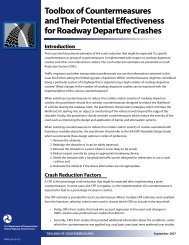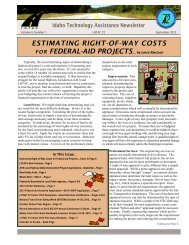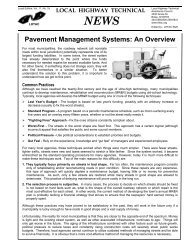Surface Contacting Tools Used in Removing Ice and Snow Pack
Surface Contacting Tools Used in Removing Ice and Snow Pack
Surface Contacting Tools Used in Removing Ice and Snow Pack
Create successful ePaper yourself
Turn your PDF publications into a flip-book with our unique Google optimized e-Paper software.
The St<strong>in</strong>gers can be used at more of an angle, but the bits have to be lubricated so they can turn <strong>in</strong> themount<strong>in</strong>g plate holes.In the summer a gravel ma<strong>in</strong>tenance grader can be equipped with a set of St<strong>in</strong>gers on the moldboard<strong>and</strong> used on gravel streets.Grader-Mounted ScarifierThe Grader-mounted scarifier is perhaps the bestknown tool <strong>and</strong> one that has been around for a longtime ( see Figure 1). However, it can be one of themost damag<strong>in</strong>g to road ways when remov<strong>in</strong>g snow <strong>and</strong>ice buildup.Dur<strong>in</strong>g construction season they become very valuable<strong>in</strong> penetrat<strong>in</strong>g up to 10 <strong>in</strong>ches <strong>in</strong>to material such as th<strong>in</strong>asphalt-surfaced roads <strong>and</strong> hard-packed base.In certa<strong>in</strong> cases, it can be a valuable tool forbreak<strong>in</strong>gthick snow <strong>and</strong> ice pack <strong>in</strong> valley gutters <strong>and</strong> dra<strong>in</strong>ageditches. Generally, its use is very limited <strong>in</strong> w<strong>in</strong>teroperations.Figure 1: A grader-mounted scarifier is generally apoor tool for break<strong>in</strong>g snowpack due to greatpotential for road surface damage.<strong>Ice</strong>Buster Grader AttachmentThe <strong>Ice</strong>Buster grader attachment is a fairly newapproach to remov<strong>in</strong>g ice <strong>and</strong> snow pack (see Figure 2).It can be attached to the front of a motorgrader on aquick hitch, on a front-end loader <strong>and</strong> on a scarifiermount beh<strong>in</strong>d the front wheels of a motor grader. Inaddition, smaller models are available for skid loaders.The <strong>Ice</strong>Buster is designed solely for ice <strong>and</strong> snow packremoval <strong>and</strong> causes very little pavement damage ( seeFigure 3).Figure 2: An <strong>Ice</strong>Buster mounted on a grader.However, the mach<strong>in</strong>e requires operator skill <strong>and</strong>responsibility <strong>in</strong> its ma<strong>in</strong>tenance <strong>and</strong> operation.Greas<strong>in</strong>g of the mach<strong>in</strong>e is very important. Thehydraulic lift on the attachment has enough downpressure to pick up the front of a grader. However thereis a variable down pressure adjustment <strong>and</strong> 500 psiseems to work best.Operat<strong>in</strong>g speed should not exceed 10 mph. Whenwork<strong>in</strong>g on residential streets with a front-mounted<strong>Ice</strong>Buster, the grader’s moldboard can be used to cleanup <strong>in</strong> one pass. Although the purpose of the <strong>Ice</strong>Busteris to break ice <strong>and</strong> snow pack, it can also be used toloosen recycled concrete <strong>and</strong> to pulverize asphaltchunks from th<strong>in</strong> pavement that has been broken up byscarify<strong>in</strong>g.Figure 3: Broken snowpack after us<strong>in</strong>g an<strong>Ice</strong>Buster. The <strong>Ice</strong>Buster works very aggressivelybut does little damage to the road surface.SummaryThis article is <strong>in</strong>tended to give you an overview of the use of surface contact<strong>in</strong>g tools for w<strong>in</strong>ter roadoperations. W<strong>in</strong>ter buildup of ice <strong>and</strong> snow is treated <strong>in</strong> many ways. The driv<strong>in</strong>g force <strong>in</strong> the decisionof what tool to use usually comes from policies, type of equipment available, permitted hours ofoperation, fund<strong>in</strong>g, traffic volume <strong>and</strong> reasonable safety for the driv<strong>in</strong>g public.Reference: UNH T2 Center, Road Bus<strong>in</strong>ess, Fall 2009, Vol. 24, No. 3






